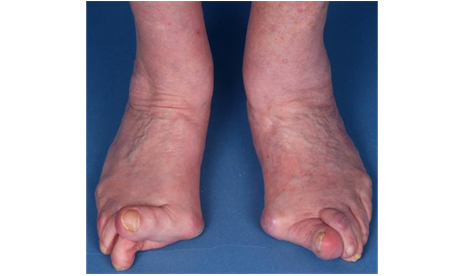Information
Hallux valgus is the term to describe a deformity of the big toe where there is an angle between the toe and the foot. This leads to widening of the foot and a prominence or bump (bunion) over the joint causing problems with footwear, inflammation of the joint and pain. The big toe can start to crowd the other toes which may also become deformed (hammer/claw toes). Sometimes pain is experienced under the ball of the foot (metatarsalgia).

Photograph of severe bunions
https://edinburghorthopaedics.org/ and approved by NHS Lothian Patient information
The cause is usually hereditary. Shoes cause the symptoms (pain and irritation), rather than causing the actual bunion. Problems are usually caused by shoes rubbing on the bump. Tight fitting shoes make the problem worse. Bunions are more common in women and more common in middle to later ages. Flat feet and hypermobility are risk factors for developing hallux valgus, as is rheumatoid arthritis.
Non-Surgical treatment
Advice: change footwear to extra width or special footwear possibly with a cushion-pad or in-shoe foot support. Advice to Avoid high heels and shoes with a narrow toe.
Podiatry: a podiatrist can help with bunion symptoms and issue pads/insoles/orthoses which can improve foot posture and pain in the joint. Patients can self refer to an NHS podiatrist or seek care privately.
Surgical treatment
Indications for surgery
Surgery may be needed if the above measures have been tried and failed. Some patients worry that the deformity may become worse and therefore prefer it to be corrected earlier rather than later. However, rapid progression of a bunion deformity is unusual. The decision to go ahead with surgery is usually made based on the following symptoms:
- To reduce pain and deformity
- To improve big toe alignment
- Make footwear more comfortable
- Improve the foot function.
Important points to note:
- Recovery from bunion correction surgery can be lengthy and there are no guarantees regarding the outcome. The bone needs to be realigned and this usually takes 6-8 weeks to heal. Swelling is common for 3 months and the final outcome is not until a year. Most patients will be off work for several weeks or longer depending on their occupation.
- Surgery is not carried out for cosmetic reasons and surgery is not carried out “prophylactically” (preventative surgery – to avoid problems that are not yet present).
M.A. & J. McK. 11-09-24
Who can refer:
GPs
Who to refer:
Criteria for referral for surgery:
- The deformity is painful and worsening
- The second toe is involved and becomes a problem
- Difficulty obtaining suitable shoes
- There is significant disruption to lifestyle or activities
- Referral for bunion surgery is needed only for pain and is not performed for cosmetic purposes.
Who not to refer:
- Cosmetic reasons
- H/o Peripheral arterial disease
- Patients who do not want to consider surgery.
How to refer:
SCI gateway (Lauriston Buildings > Orthopaedics – Foot and Ankle)
Minimal referral Details:
- Length of time since symptoms started
- Non-operative management tried
- Patient has been seen by podiatry
Non-Surgical treatment
Advice: change footwear to extra width or special footwear possibly with a cushion-pad or in-shoe foot support. Advice to Avoid high heels and shoes with a narrow toe.
Podiatry: a podiatrist can help with bunion symptoms and issue pads/insoles/orthoses which can improve foot posture and pain in the joint. Patients can self refer to an NHS podiatrist or seek care privately.
Bunion Correction Surgery: https://edinburghorthopaedics.org/media/cfikoe2l/bunion-correction-surgery-v2-0.pdf













